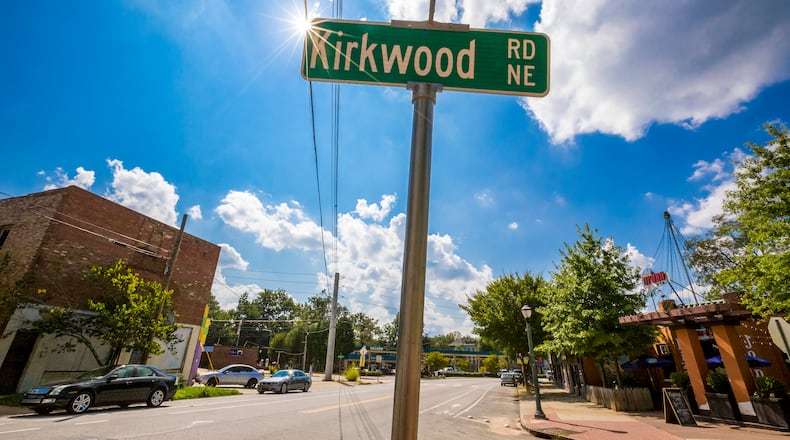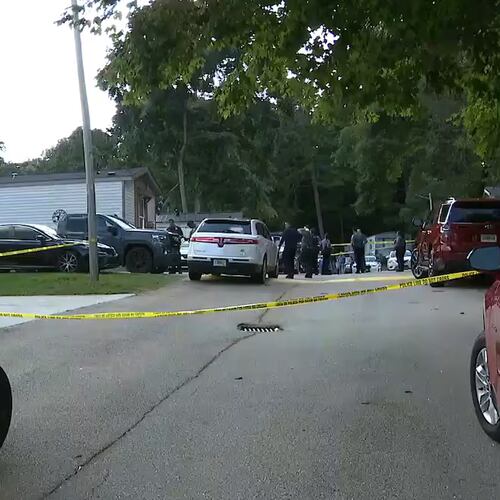Bill Stanley sits in the sunlit lobby of his architecture firm, on a bench surrounded by authentic African art and live indoor plants. He’s owned this squat brick building on Spring Street in Midtown — just east of the interstate, several blocks west of Piedmont Park — for nearly 25 years.
Stanley is a fourth-generation Atlantan, the first Black graduate of the architecture school at nearby Georgia Tech.
And like many of the city’s residents, he has plenty of thoughts on Atlanta’s future — and the key issues that the next mayor should tackle.
Current Atlanta Mayor Keisha Lance Bottoms is not running for reelection, and early voting in the crowded Nov. 2 election to replace her begins today.
With that in mind, The Atlanta Journal-Constitution dispatched reporters to seven neighborhoods across Atlanta to ask residents, business owners and others what they think the next mayor should prioritize — for their own communities and the city as a whole.
VIDEO SERIES: WHAT ATLANTA NEIGHBORHOODS WANT FROM THE NEXT MAYOR
In this online exclusive, hear what Atlantans in the Summerhill, Vine City, Westview, North Buckhead, Midtown, Kirkwood and Cascade Heights neighborhoods have to say about the main issues facing mayoral candidates. NOTE: Click the video below to see all seven videos in succession, or choose from this story list.
Unsurprisingly, opinions varied across the city. But many residents had priorities similar to those Stanley expressed: improving infrastructure and general quality of life issues; tackling crime and its root causes; and finding a way to provide — and protect — more affordable housing.
“You cannot have a city of such harsh class distinction that people who could benefit from living in an area can’t do so,” Stanley said.
A few miles southwest of Stanley’s Midtown office, the neighborhood of Westview is seeing a wave of new investment and development that’s spurred in part by the arrival of the Beltline.
Lined with bungalows and Tudor-style homes from the early 1900s, Westview’s residential streets are home to mostly Black homeowners, but its share of white residents has gone up in recent years.
Home values have also skyrocketed in the last half-decade, with some houses now selling for more than $500,000.
While crime and responsiveness to emergency calls is a top-of-mind issue for many in Westview, the biggest concern may be keeping legacy residents in their homes.
“I get so many phone calls and emails about selling my house,” said Emma Jean Davis, who has lived in the neighborhood since 1984. “That’s pressure, and if I wasn’t strong enough I would give in.”
“I think our voices are not really heard downtown,” she added.
Folks in Summerhill, an historically Black neighborhood in the shadow of the former Turner Field, are dealing with similar concerns. Commercial and residential development has actually surged since the Braves left town in 2017; but the local poverty rate remains north of 36%.
Credit: Ryon Horne / Ryon.Horne@ajc.com
Credit: Ryon Horne / Ryon.Horne@ajc.com
Longtime residents Justina and Emanuel Dix are trying to hold on through another wave of gentrification and displacement.
“We don’t want segregation to start forming in the midst of the diversity, because that means we’re going backwards,” Justina Dix said.
Across the city, there are plenty of other concerns as well.
The affluent southwest Atlanta neighborhood of Cascade Heights is a longtime magnet for local politicians making their own homes, the current mayor included. But residents say the city has long-neglected infrastructure and other quality of life issues in their community.
Several residents said potholes remain prevalent, trash does not get picked up regularly, and parts of Cascade Road, the major thoroughfare in the area, do not have sidewalks. The main business district has remained stagnant for years.
“You would think there are priorities to fix all of our neighborhoods,” said Shea Embry, who has worked to bring new businesses to the area since moving there six years ago. “Cascade Heights and Cascade Road is a major thoroughfare, and it should be given the same consideration as Howell Mill Road or in Buckhead.”
Crime and cityhood
Over the last year-plus, violent crime has surged throughout Atlanta (as well the rest of the metro area, the state, and most of the country). Residents across the city, including the Dixes of Summerhill, say it has to be a priority for the next mayor.
But nowhere has the conversation reached a fever pitch like it has in Buckhead, the affluent, predominantly white neighborhood on the far north end of the city. Bill White, a three-year resident of the area, and a handful of state legislators from outside Atlanta have used crime fears to push for Buckhead to secede from the city and create its own municipality.
Jackie Goodman, 72, has lived in North Buckhead since 1980. She said she doesn’t support the cityhood movement — but crime around commercial areas like Lenox Mall remains top-of-mind for her and her neighbors.
Odell Horne, a resident and affordable housing advocate in east Atlanta’s rapidly gentrifying Kirkwood neighborhood, said it’s hard to separate the city’s inequality and its crime. He said he hopes the next mayor will tackle both in a substantive way.
“If we’re not getting our young men jobs and education and sound housing, we’ll get a rise in crime,” Horne said.
Several miles back west, in the shadow of Mercedes-Benz Stadium, residents of Vine City see a mix of hope and concern on the horizon.
Nearly 90% of the neighborhood’s residents are Black. More than 40% live in poverty. Their community is one of Atlanta’s oldest — and one long plagued by blight and crime.
Credit: Steve Schaefer
Credit: Steve Schaefer
There’s hope that the recently completed Rodney Cook Sr. Peace Park can fuel revitalization, but directly addressing things like housing and economic mobility are crucial, said Colette Haywood, a longtime resident and vice chair of the local Neighborhood Planning Unit.
Neighbor Tillman Ward said he appreciates the investments that have been made in Vine City, but Atlanta’s next mayor also should help tackle access to fresh food and affordable transportation.
And above all, Ward said, the future needs to be guided by genuine engagement with members of the community — all of them.
“From the uttermost to the gutter-most,” he said.
— Reporters J.D. Capelouto, Anjali Huynh, Sarah Kallis and Wilborn Nobles contributed to this article.
Visit AJC.com to watch video interviews The Atlanta Journal-Constitution conducted with residents across the city of Atlanta.
And make sure to check in at ajc.com/news/atlanta-mayors-race-2021/ for all of the AJC’s latest coverage of the Race for Atlanta City Hall.
Credit: Tyson Horne
Credit: Tyson Horne
Cascade Heights
Relatively affluent and historically Black neighborhood bisected by Cascade Road in southwest Atlanta, south of Benjamin Mays Road and east of I-285. Very suburban area in both Districts 10 and 11 that contains the Cascade Nature Preserve, as well as several small businesses that are highlighted at a market the third Saturday of every. Signs endorsing local elections candidates and advertising a campaign to keep the neighborhood clean are found on nearly every lawn, indicating high levels of political engagement.
Demographics, according to 2019 data from Neighborhood Nexus:
Population: 3,110
Median household income: $58,172
Median age: 47
Race: 3.4% white, 95.1% black, 0% Asian, 0.8% Hispanic/Latino (of any race)
Unemployment rate: 5.4%
Poverty rate: 14.5%
Median home value (of owner-occupied units): $165,342
Percent of rental units: 35.7%
Percent of owner-occupied units: 64.3%
Percent of rents above $1000: 55.1%
Credit: Jenni Girtman
Credit: Jenni Girtman
Kirkwood
Kirkwood is a historic neighborhood in East Atlanta, bound by DeKalb Avenue on the north end and Memorial Drive and I-20 to the south. The neighborhood has a walkable retail and restaurant district clustered mostly along one street in between rows of historic neighborhoods. It was a historically white suburb when it was first built in 1899, but then became mostly Black after white flight in the mid 20th century. It is now majority white again.
Demographics
Population: 6,487
Median household income: $110,242
Median age: 35
Race: 59.8% white, 30.4% Black, 2.4% Hispanic or Latino, 1.3% Asian, 6.1% other
Unemployment rate: 7% (this could have changed since COVID)
Poverty rate: 9.7%
Median home value (of owner-occupied units): $365,281
Percent of rental units: 30.7%
Percent of owner-occupied units: 69.3%
Percent of rents above $1,000: 53.4%
Credit: HYOSUB SHIN / AJC
Credit: HYOSUB SHIN / AJC
Midtown
Midtown is an expansive community that boasts high-rises full of young professionals, student housing for Georgia Tech and affluent single-family neighborhoods. In addition to being an epicenter for business, it’s home to some of Atlanta’s most treasured landmarks, including Piedmont Park, the Fox Theatre and the High Museum of Art, and is the center of LGBTQ life in the city.
Midtown is in the middle of a dramatic boom in development.
Demographics
Population: 52,616
Median household income: $83,196
Median age: 29
Race: 60% white, 17.4% Black, 13% Asian, 5.7% Hispanic or Latino, 3.8% other
Unemployment rate: 3.1% (this could have changed since COVID)
Poverty rate: 16.1%
Median home value (of owner-occupied units): $320,827
Percent of rental units: 60.9%
Percent of owner-occupied units: 39.1%
Percent of rents above $1,000: 73.4%
Credit: HYOSUB SHIN / AJC
Credit: HYOSUB SHIN / AJC
North Buckhead
Large neighborhood in northeast Buckhead (30342) that spans from Phipps Plaza to the northern city boundary. Includes lots of retail and businesses, as well as spacious neighborhoods with large homes.
Demographics
Population: 9,691
Median household income: $127,673
Median age: 40
Race: 77.3% white, 9.5% Black, 8.9% Asian, 2.8% Hispanic or Latino
Unemployment rate: 4% (this could have changed since COVID)
Poverty rate: 5.6%
Median home value (of owner-occupied units): $606,063
Percent of rental units: 36.6%
Percent of owner-occupied units: 63.4%
Percent of rents above $1000: 82.8%
Summerhill
A community positioned between I-85/I-20 near the former Turner Field. It was founded in 1865 as Atlanta’s first neighborhood for freed enslaved Blacks and Jewish immigrants. The neighborhood experienced a temporary surge of development when the stadium was built to host the 1996 Olympics, and later converted into a baseball park to house the Braves, but the team left Atlanta in 2017. The city is currently working with developers to revitalize Summerhill once again with apartments, retail and grocery stores.
Demographics
Population: 3,117
Median household income: $37,960
Median age: 33
Race: 30.6% white, 59.2% Black, 3.2% Asian, 5.2% Hispanic or Latino
Unemployment rate: 6.9% (this could have changed since COVID)
Poverty rate: 36.5%
Median home value (of owner-occupied units): $304,968
Percent of rental units: 68%
Percent of owner-occupied units: 32%
Percent of rents above $1000: 44.8%
Vine City
Located west of Mercedes-Benz Stadium and Northside Drive, Vine City originated in the 1800s along the headwaters of Proctor Creek as a working community around a large plant nursery business. Some notable figures, including Julian Bond, Maynard Jackson, Martin Luther King Jr., and Mrs. Coretta Scott-King, lived in the historic Black neighborhood. Vine City has experienced poverty, blight, and crime for years as part of an area called “The Bluff.” But the city hopes to revitalize the area to attract new neighbors and private development -- while retaining longtime residents -- using the presence of the stadium and the recently completed Rodney Cook Sr. Peace Park. The area is surrounded by Atlanta’s historically black colleges and universities.
Demographics
Population: 4,486
Median household income: $31,103
Median age: 30
Race: 4.1% white, 89.9% Black, 1.3% Asian, 2% Hispanic or Latino
Unemployment rate: 8.5% (this could have changed since COVID)
Poverty rate: 41.8%
Median home value (of owner-occupied units): $138,043
Percent of rental units: 85.1%
Percent of owner-occupied units: 14.9%
Percent of rents above $1000: 39.8%
Westview
Tightknit, politically engaged neighborhood in 30310 located just south of I-20 in southwest Atlanta and adjacent to the Beltline; has lots of longtime legacy residents but a wave of new, younger residents is starting to come in amid a huge rise in home prices. Adjacent to the West End, it has a commercial corridor and several small businesses.
Demographics
Population: 3,505
Median household income: $38,534
Median age: 37
Race: 6.6% white, 88.8% Black, 1.2% Asian, 2.3% Hispanic or Latino
Unemployment rate: 10.8% (this could have changed since COVID)
Poverty rate: 18.4%
Median home value (of owner-occupied units): $193,514
Percent of rental units: 59.9%
Percent of owner-occupied units: 40.1%
Percent of rents above $1000: 41.3%
About the Author
Keep Reading
The Latest
Featured












